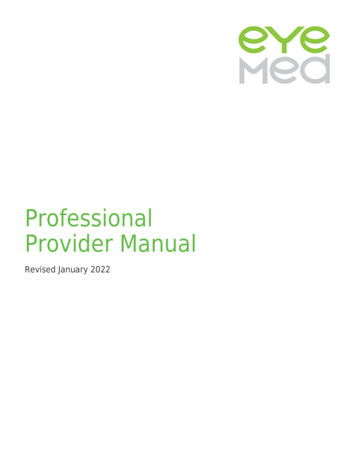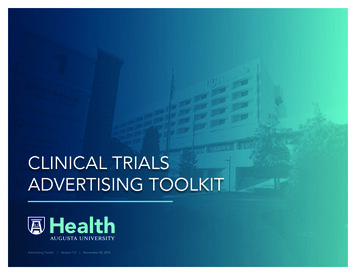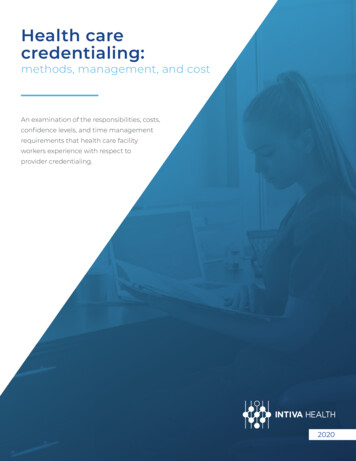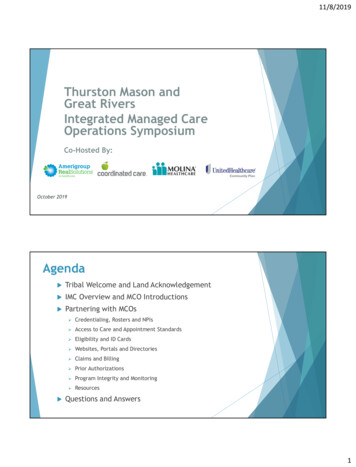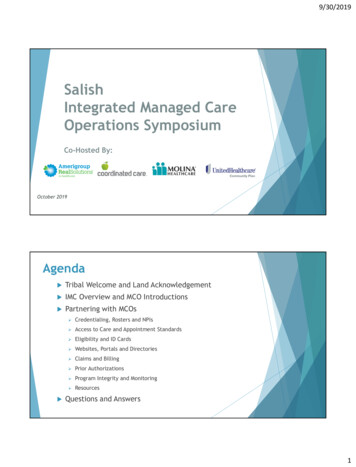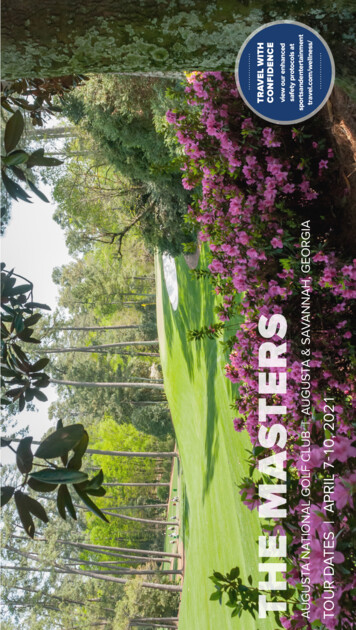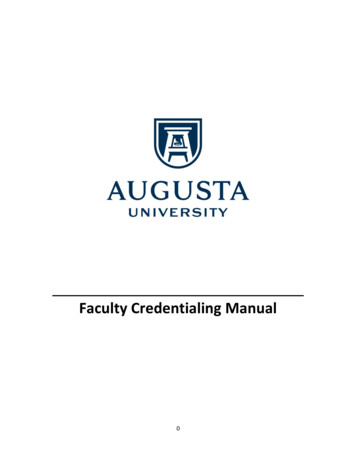
Transcription
Faculty Credentialing Manual0
Table of ContentsPurpose . 2Section 1: Augusta University’s Standard Criteria for Faculty Credentialing . 3Undergraduate Courses (Course Numbers 1000-4000) . 3Graduate and Post-Baccalaureate Courses (Course Numbers 5000) . 3Wellness Activity Courses (WELL1xxx level courses) . 3Section II: Roles & Responsibilities . 4Faculty Member . 4Department Chair and/or Program Directors . 4Deans . 5Vice President for Academic and Faculty Affairs (VPAFA) . 5Vice President for Institutional Effectiveness (VPIE) . 5Section III: Documenting Alternative Justifications for Faculty Credentials . 6Closely Related Degrees. 6Advanced Course Work. 6Substantial Accomplishments in the Field . 6 Significant Professional Experience . 7Appendix A - SACS Faculty Credentials Guidelines . 8Appendix B - Terminal and Closely Related Degrees . 9COLLEGE OF ALLIED HEALTH AND SCIENCES (CAHS) [verified]. 9PAMPLIN COLLEGE OF ARTS, HUMANITIES AND SOCIAL SCIENCES (CAHSS) [verified] . 11HULL COLLEGE OF BUSINESS (HCB) [verified] . 13COLLEGE OF DENTAL MEDICINE (CDM) . 14COLLEGE OF EDUCATION (COE) . 15COLLEGE OF NURSING (CON) [verified] .COLLEGE OF SCIENCE AND MATHEMATICS (CSM) [Verified] . 19THE GRADUATE SCHOOL (TGS) [verified] . 21MEDICAL COLLEGE OF GEORGIA (MCG) . 23Appendix C - Faculty Credentialing Rules .1
PurposeFaculty credentialing is a complex process that requires the coordinated efforts of senior leaders,academic programs, support service units, and multiple software systems. The goal of this manual is toprovide one authoritative source for each of the steps involved in the faculty credentialing process.Following this process will help Augusta University meet the accreditation principles of the SouthernAssociation of Colleges and Schools Commission on Colleges (SACSCOC).The Augusta University Faculty Credentials Work Team developed this manual by working withrepresentatives from each of the administrative units involved in the faculty credentialing process aswell as representatives from each college within the University. From this foundation, the committee,following the Faculty Credentialing Guidelines1 provided Southern Association of Colleges and SchoolsCommission on Colleges (SACSCOC), developed the established “standard criteria” that will qualifypotential instructors to teach each Augusta University course. These standard criteria, outlined in thismanual, represent the process Augusta University will use to document the fact that all faculty whoteach 10% or more of a course’s content possess the academic preparation, training, and experienceneeded to meet the requirements of SACSCOC and other accrediting bodies and state agencies, as theyrelate to each Augusta University course offering.Standards found in this manual apply to all academic program directors, full-time and part-time teachingfaculty, lab supervisors, and graduate teaching assistants whether they are teaching on our campuses,on the web, or off campus. Department chairs and/or program directors should be aware that bothAugusta University and SACSCOC guidelines allow bounded flexibility in establishing faculty credentials.Potential instructors who do not meet the “standard criteria” for credentialing may still qualify by virtueof other qualifications. These additional qualifications must be spelled out as part of an “alternativejustification,” which has been made a part of this manual. When qualifications other than the “standardcriteria” are used to establish credentials to teach a course, this must be reviewed and approved by theDean of the college in which the course is being offered and the Vice President for Academic and FacultyAffairs.1Appendix A2
Section 1: AU’s Standard Criteria for Faculty CredentialingFaculty credentialing standards apply to all faculty members and graduate teaching assistants(GTAs) who teach 10% or more of a course’s academic content.Undergraduate Courses (Course Numbers 1000-4000)Faculty members teaching undergraduate courses should possess: A terminal degree or master’s degree in the teaching discipline, or A master’s degree in any field with a minimum of 18 graduate semester hours in theteaching discipline.Graduate Teaching Assistants2 (GTAs) should: Possess a master’s in the teaching discipline, or 18 graduate semester hours in theteaching discipline, Be directly supervised by a faculty member experienced in the teaching discipline, Engage in regular in-service training, and Receive planned and periodic evaluations of their teaching performance.Graduate and Post-Baccalaureate Courses (Course Numbers 5000)Faculty teaching graduate and post-graduate courses should possess: An earned doctorate or terminal degree in the teaching discipline, or in a closelyrelated discipline.Wellness Activity Courses (WELL1xxx level courses)Faculty teaching Wellness Activity courses should possess: A bachelor’s degree (in any discipline?) and substantial qualifications in the area ofinstruction (i.e., Dance, Golf, Sports and Games)If a faculty member does not meet the above credentialing requirements, an alternativejustification is required. (See Section III: Documenting Alternative Justifications)2A credentialing review for a GTA should ensure that any student holding such a position meets all therequirements outlined in the Augusta University Graduate Teaching Assistant Policy. [See GraduateTeaching Assistant policy]3
Section II: Roles & ResponsibilitiesFaculty MemberIt is the responsibility of a faculty member to provide evidence of teaching credentials. Theseinclude: Official transcripts from domestic, accredited institutions Translated, evaluated, and certified foreign credentials (if applicable), Copies of licenses or certifications (if applicable).In instances when these documents do not meet the standard credentialing requirementsidentified in Section 1, additional documentation may be needed to support the production ofan alternative justification. These may include, but are not limited to, Documents verifying related work experience, Current curriculum vitae.Department Chair and/or Program DirectorsIt is the responsibility of department chairs and/or program directors to: Ensure the receipt of official transcripts for all departmental faculty and forward toHuman Resources for the faculty member’s permanent record. Examine all prospective faculty member’s credentials to verify they meet therequirements of the position and the SACSCOC faculty credentialing guidelines3 foreach of the courses the faculty member may be assigned. Each time a faculty member is assigned to teach a new course, examine thecredentials to verify they meet the SACSCOC faculty credentialing guidelines for thenew course. Ensure the qualifications of all Graduate Teaching Assistants used to provideacademic instruction and provide appropriate supervision and training as outlinedin Section 1.In instances when these documents do not meet the standard credentialing requirementsidentified in Section 1, additional documentation may be needed to support the production ofan alternative justification. The Department Chair must draft an alternative justification and forward to theDean of the college of instruction for approval.3Appendix C4
DeansIt is the responsibility of Deans to: Ensure that all faculty teaching in their college meet the requirements of theirpositions and the SACSCOC faculty credentialing guidelines for each of the coursesthe faculty member may be assigned. Ensure the qualifications of all Graduate Teaching Assistants used to provideacademic instruction and provide appropriate supervision and training as outlinedin Section 1.In instances when these documents do not meet the standard credentialing requirementsidentified in Section 1, additional documentation may be needed to support the production ofan alternative justification. The Dean should approve alternative justifications and forward to the VicePresident for Academic & Faculty Affairs for approval.Vice President for Academic and Faculty Affairs (VPAFA)It is the responsibility of the VPAFA to: Review the assignment of Classification of Instructional Program (CIP) codes to allfaculty held degrees, academic programs and courses; Review the cross reference between terminal degrees and AUGUSTA UNIVERSITY’sacademic programs identified in Appendix B4; Provide support and guidance for the development of alternative justifications; Approve all alternative justifications; Approve the Faculty Credentialing Manual.Vice President for Institutional Effectiveness (VPIE)It is the responsibility of the VPIE to: Maintain this Faculty Credentialing manual in order to facilitate compliance with theSACSCOC expectations and relevant Augusta University policies and procedures; Conduct ongoing reviews to assess the institution’s compliance with facultycredentialing and qualification standards and notify the VPAFA when alternativejustifications may be needed; Provide support and guidance for the development of Alternative Justifications Run a report to verify faculty credentialing using CIP codes. If the CIP code for a facultymember’s degree and the course they are assigned to teach do not match, the systemof record will be checked for an alternative justification. If an adequate justification isnot found, the VPIE will notify the VPAFA and Dean of the college in which the facultymember is teaching so that a justification can be provided.4Appendix B5
Section III: Documenting Alternative Justifications for FacultyCredentialsWhen an Alternative Justification is required, acceptable evidence of appropriate alternativecredentials must be provided. One or more of the following is required depending upon thelevel of the course. The four types of alternative justifications described below are listed in thepreferred order to make the strongest case possible.Closely Related DegreesIn cases where the faculty member does not hold a degree in the teaching discipline, butholds a degree that is consider a closely related degree (See Appendix B), the personalizedAlternative Justification below should be included:Augusta University has developed a list of Universally Acceptable Alternative degrees tocredential faculty to teach within our various academic programs. Faculty Name holds a degree name degree from institution name which has been evaluated as anacceptable alternative by the DEFINING AUTHORITY OR ACCREDITING BODY .Advanced Course WorkDocumentation that the faculty member holds a Master’s degree in any field and hascompleted 18 semester credits of graduate level coursework in the teaching field can serveas the basis for the instructional assignment at the undergraduate course level.If used for graduate course credentialing, this must be combined with other documentationdescribed in subsequent sections below.Documentation should include: The list of Courses including institution name, prefix/number, course name, andterm/year in which the credits were earned A short narrative explanation of how this academic preparation has prepared the facultymember to teach the course’s student learning outcomes.NOTE: These graduate semester credit hours must be consist of formal coursework.Normally, thesis, dissertation, internship, and similar credits do not count towards thedocumentation of 18 hours of graduate credit unless accompanied by an explanation of therelevance (or learning outcomes if available) for each course.Substantial Accomplishments in the FieldDocumentation that the faculty member has a record of substantial and currentaccomplishments in the field of the teaching assignment. Documentation could includeitems such as: Abstracts of published work, taken directly from the journals or proceedings,6
Evidence of book publication, including the rigor of the reviewing process and press,Copies of published reviews of an exhibition or performance,Copies of book reviews published in scholarly journals or similarly significant venues,Other noteworthy activities.Significant Professional ExperienceDocumentation that the faculty member has significant professional experience in an areathat would provide the qualifications needed to teach the learning outcomes associatedwith a given course. Documentation could include items such as: The Curriculum Vita with relevant portions detailing the professional experienceshighlighted or other documents that verify relevant positions held, An explanation of how the professional experience relates to course-level studentlearning outcomes, Letters of support from an employer or co-workerIn all cases, the accomplishments must be independently verified and the hiring authorityshould ensure the documents are placed in the faculty member’s permanent employmentrecord.7
Appendix A - SACS Faculty Credentials GuidelinesSouthern Association of Colleges and SchoolsCommission on Colleges1866 Southern LaneDecatur, Georgia 30033-4097FACULTY CREDENTIALS- Guidelines –Comprehensive Standard 3.7.1 of the Principles of Accreditation reads as follows:The institution employs competent faculty members qualified to accomplish the mission and goalsof the institution. When determining acceptable qualifications of its faculty, an institution givesprimary consideration to the highest earned degree in the discipline. The institution also considerscompetence, effectiveness, and capacity, including, as appropriate, undergraduate and graduatedegrees, related work experiences in the field, professional licensure and certifications, honorsand awards, continuous documented excellence in teaching, or other demonstratedcompetencies and achievements that contribute to effective teaching and student learningoutcomes. For all cases, the institution is responsible for justifying and documenting thequalifications of its faculty.When an institution defines faculty qualifications using faculty credentials, institutions should use thefollowing as credential guidelines:a. Faculty teaching general education courses at the undergraduate level: doctorate or master’sdegree in the teaching discipline or master’s degree with a concentration in the teachingdiscipline (a minimum of 18 graduate semester hours in the teaching discipline).b. Faculty teaching associate degree courses designed for transfer to a baccalaureate degree:doctorate or master’s degree in the teaching discipline or master’s degree with a concentration inthe teaching discipline (a minimum of 18 graduate semester hours in the teaching discipline).c. Faculty teaching associate degree courses not designed for transfer to the baccalaureatedegree: bachelor’s degree in the teaching discipline, or associate’s degree and demonstratedcompetencies in the teaching discipline.d. Faculty teaching baccalaureate courses: doctorate or master’s degree in the teachingdiscipline or master’s degree with a concentration in the teaching discipline (minimum of 18graduate semester hours in the teaching discipline).e. Faculty teaching graduate and post-baccalaureate course work: earned doctorate/terminaldegree in the teaching discipline or a related discipline.f. Graduate teaching assistants: master’s in the teaching discipline or 18 graduate semesterhours in the teaching discipline, direct supervision by a faculty member experienced in theteaching discipline, regular in-service training, and planned and periodic evaluations.Approved: College Delegate Assembly, December 20068
Appendix B - Terminal and Closely Related DegreesCOLLEGE OF ALLIED HEALTH AND SCIENCES (CAHS) [verified]ACADEMIC DISCIPLINEDental Hygiene(BS, MS in AH)Health Informatics (BS)TERMINAL DEGREE(S)NEEDED FOR FACULTY TOTEACH IN DISCIPLINEB.S. in field1.2.3.1.B.S. in field2.Public Health (MPH)DPH (Doctor of Public Health)Medical Illustration(MS)M.S. in Medical Illustration1.2.3.1.2.Clinical Lab Science (BS)Clinical Lab Science (MS)B.S. in fieldB.S. in fieldRadiation Therapy (BS)B.S. in fieldOccupational Therapy(MHS)Physician Assistant(MPA)1. Master of Public Health2. M.D.3. OD1. Master of Public Health2. M.D.3. ODClinical Professor must alsohave Bachelor's in HealthSciences or EducationM.S. in relevant disciplineM.S. in fieldNuclear Medicine Tech(BS)UNIVERSAL ACCEPTEDALTERNATIVEM.S. in Dental HygieneDMDDDSRegistered HealthInformationAdministratorM.S. in: Information Systems InformationTechnology Economics Finance MBAPh.D. in health policyM.D.ODM.A. from John's Hopkinsin fieldCertified MedicalIllustrator (CMI)1. Ph.D.2. O.T.D.3. ScD.M.S. in fieldM.S. in Occupational TherapyB.S., in relevant disciplineand Licensed Certified P.A.9DEFINING AUTHORITY ORACCREDITING BODYCODA: Commission on DentalAccreditation(CAHIIME) Commission onAccreditation for HealthInformatics and InformationManagement Education(CEPH) Council onEducation for PublicHealth(ARCMI) AccreditationReview Council for MedicalIllustration(NAACLS) NationalAccrediting Agency for ClinicalLab Sciences(NAACLS) NationalAccrediting Agency for ClinicalLab Sciences(JRCNMT) Joint ReviewCommittee in NuclearMedicine Technology(JRERT) Joint Review onEducation for RadiologicTechnology(ACOTE) Accrediting Councilfor Occupational TherapyEducation(ARCPA) Accrediting ReviewCommittee for the PhysicianAssistant
Physical Therapy (DPT)Respiratory Therapy(BS)D.P.T.1. Ph.D.2. ScD. in relevant disciplineM.S. in fieldB.S. Respiratory Therapy andPh.D. relevant discipline10(CAPTE) Commission onAccreditation in PhysicalTherapy Education(CoARC) Coalition ofAdvanced Respiratory Care
PAMPLIN COLLEGE OF ARTS, HUMANITIES AND SOCIAL SCIENCES (CAHSS) [verified]ACADEMIC DISCIPLINETERMINAL DEGREE(S)NEEDED FOR FACULTY TOTEACH IN DISCIPLINEUNIVERSAL ACCEPTEDALTERNATIVEDEFINING AUTHORITY ORACCREDITING BODYArt (BA and BFA)MS in Art History for ArtHistory courses(NASAD) NationalForeign Languages (BA)1. M.F.A. in Art (with subfield in area of course.e.g. Painting, Ceramics,etc.);2. PhD in Art History for ArtHistory course1. Ph.D. Communications2. M.F.A. in relevant field(e.g. Photography,Creative Writing, Theater- when in a performancefield or technical field,etc.)1. Ph.D. Literature, Englishor appropriate field2. M.F.A. for creativewritingPh.D. in fieldAnthropology (BA)Ph.D. in fieldHistory (BA)Ph.D. in HistoryMusic (BA)1.1.2.3.Communications (BA)English (BA)Music Education (BM)Music Performance (BM)Political Science (BA)M.A. in Communications;M.A. in Lit or appropriatefieldM.A. in Language beingtaughtM.A. in Anthropology1.2.1.2.D.M.D.M.A.D.MusMus.D. in music1. Ph.D. Music Education2. D.M.3. D.M.APh.D., in subject areaM.A. in HistoryM.A.M.M. in discipline forPart-Time1. M.A.2. M.M. (in music or musiceducation) for PartTime/D.M. or D.M.A. forFull-TimePh.D. in ethnomusicology ormusicology1. D.M.2. D.M.A. (music arts)1. Ph.D. Political Science,Ph.D. internationalstudies2. Ph.D. Public Policy3. Ph.D. PublicAdministrationM.A. any of the followingareas (political science,government, internationalrelations, publicadministration.)11Association of Schools of Artand Design(NASM) National Associationfor Schools of Music(NASM) National Associationfor Schools of Music(NASM) National Associationfor Schools of Music
Public Administration(MPA)1. Ph.D. PublicAdministration2. PhD. Public PolicyCriminal Justice (BA)Ph.D. Criminal JusticeSocial Work (BSW)Ph.D. Social WorkSociology (BA)Ph.D. Sociology(NASPAA) NationalAssociation of Schools forPublic Affairs andAdministration1. Ph.D. Sociology,2. M.A. Criminal Justice3. M.A. Sociology(CSWE) Council for SocialWork EducationM.A. Sociology12
HULL COLLEGE OF BUSINESS (HCB) [verified]ACADEMIC DISCIPLINEUNIVERSAL ACCEPTEDALTERNATIVEDEFINING AUTHORITY ORACCREDITING BODY1. MACC2. DBA3. MBA, with alternativeJustification4. CPA1. MBA PLUS 18 graduatecredits in finance2. M.S. PLUS 18 graduatecredits in finance(AACSB) Association toPh.D. in Business-relateddisciplineMBA PLUS 18 graduatesemester hours in Business,Management, Marketing orAdministration(AACSB) Association toManagementInformation Systems(BBA)Ph.D. in Business-relateddisciplineMBA PLUS 18 graduatesemester hours in MIS orrelated field(AACSB) Association toMarketing (BBA)Ph.D. in Business-relateddisciplineMBA PLUS 18 graduatesemester hours inManagement, Marketing, orAdministration(AACSB) Association toBachelor of BusinessAdmin (BBA)Ph.D. in Business-relateddisciplineMBA(AACSB) Association toApplied Info Systemsand Tech (BS)Ph.D. in BusinessAdministration withemphasis in MIS, InformationTechnology, or ComputerScienceComputer Science (BS)Ph.D. in Computer ScienceMaster of BusinessAdministration (MBA)Ph.D. in Business-relateddisciplineM.S. in ComputerEngineering, ComputerScience, SoftwareEngineering, InformationSystems and InformationTechnology1. Ph.D. in InformationTechnology or BusinessAdministration (withemphasis inManagementInformation Systems)2. MS in Computer Science,Computer Systems,Information Technology,EngineeringMBA and ProfessionalExperienceAccounting (BBA)Finance (BBA)Management (BBA)TERMINAL DEGREE(S)NEEDED FOR FACULTY TOTEACH IN DISCIPLINEPh.D. in Business-relateddisciplinePh.D. in Business-relateddisciplineAdvance Collegiate Schools ofBusiness(AACSB) Association toAdvance Collegiate Schools ofBusinessAdvance Collegiate Schools ofBusinessAdvance Collegiate Schools ofBusinessAdvance Collegiate Schools ofBusinessAdvance Collegiate Schools ofBusiness13(AACSB) Association toAdvance Collegiate Schools ofBusiness
COLLEGE OF DENTAL MEDICINE (CDM)ACADEMIC DISCIPLINETERMINAL DEGREE(S)NEEDED FOR FACULTYTO TEACH IN DISCIPLINEUNIVERSAL ACCEPTEDALTERNATIVEDEFINING AUTHORITY ORACCREDITING BODYDental Medicine (DMD)1. D.M.D.2. D.D.S.3. Ph.D., in oral biologyPh.D. in a field directlyrelated to course contenttaughtCommission of DentalAccreditation of theAmerican DentalAssociation14
COLLEGE OF EDUCATION (COE)ACADEMIC DISCIPLINECounselor Education(EDS)TERMINAL DEGREE(S)NEEDED FOR FACULTYTO TEACH IN DISCIPLINE1. Ph. D. in CounselorEducation2. Ed.D. in CounselorEducationCounselor Education(MED)1. Ph. D. in CounselorEducation2. Ed.D. in CounselorEducationEducational Leadership(EDS)1. Ph. D. in EducationLeadership andAdministration relateddiscipline2. Ed.D. in EducationLeadership andAdministration relateddiscipline1. Ph. D. in EducationLeadership andAdministration relateddiscipline2. Ed.D. in EducationLeadership andAdministration relateddiscipline1. Ph. D. in TeacherEducation or Curriculumand Instruction2. Ed.D. in TeacherEducation or Curriculumand Instruction1. Ph.D. in Health andPhysical Education2. Ed.D. in Health andPhysical Education3. Ph.D. in Kinesiology4. Ed.D. in KinesiologyEducational Leadership(MED)Teacher Leadership(MED)Health and Physical Ed(BSED)UNIVERSAL ACCEPTEDALTERNATIVEDEFINING AUTHORITY ORACCREDITING BODY1. Ph.D. or Ed.D. inCounseling Psychology2. Ph.D. or Ed.D. in SchoolCounseling/Psychology3. Ph.D. or Ed.D. inCommunityCounseling/Psychology1. Ph.D. or Ed.D. inCounseling Psychology2. Ph.D. or Ed.D. in SchoolCounseling/PsychologyPh.D. or Ed.D. in CommunityCounseling/Psychology(CAEP) Council for theAccreditation of EducatorPreparation, formerly NCATE(CAEP) Council for theAccreditation of EducatorPreparation, formerly NCATE(CAEP) Council for theAccreditation of EducatorPreparation, formerly NCATE(CAEP) Council for theAccreditation of EducatorPreparation, formerly NCATE(CAEP) Council for theAccreditation of EducatorPreparation, formerly NCATE1. Ed.S. in Health andPhysical Education2. M.Ed. in Health andPhysical Education3. Masters in Kinesiology15(CAEP) Council for theAccreditation of EducatorPreparation, formerly NCATE
Kinesiology (BS)1.2.3.4.Ph.D. in KinesiologyEd.D. in KinesiologyDPTDPHKinesiology (MS)3.4.5.6.Ph.D. in KinesiologyEd.D. in KinesiologyDPTDPHCurriculum & Instruction(EDS)1. Ph.D. in Curriculum andInstruction2. Ed.D. in Curriculum andInstruction1. Ph.D. in Curriculum andInstruction2. Ed.D. in Curriculum andInstruction1. Ph.D. in Early ChildhoodEducation or TeacherEducation2. Ed.D. in Early ChildhoodEducation or TeacherEducationCurriculum & Instruction(MED)Early Childhood Ed(BSED)Master of Arts inTeaching (MAT)Foreign Language Ed(MAT)Health and Physical Ed(MAT)1. Ed.S. in Kinesiology2. Masters in Kinesiology1. Ph.D. in Curriculum andInstruction or TeacherEducation2. Ed.D. in Curriculum andInstruction or TeacherEducation1. Ph.D. in Curriculum andInstruction or TeacherEducation2. Ed.D. in Curriculum andInstruction or TeacherEducation3. Ph.D. in ForeignLanguage Education orlanguage area1. Ph.D. in Curriculum andInstruction or TeacherEducation2. Ed.D. in Curriculum andInstruction or TeacherEducation3. Ph.D. in Health andPhysical Education(CAEP) Council for theAccreditation of EducatorPreparation, formerly NCATE(CAEP) Council for theAccreditation of EducatorPreparation, formerly NCATE1. Ed.S. in Early ChildhoodEducation or TeacherEducation2. M.Ed. or equivalent inEarly ChildhoodEducation or TeacherEducation(CAEP) Council for theAccreditation of EducatorPreparation, formerly NCATE(CAEP) Council for theAccreditation of EducatorPreparation, formerly NCATE(CAEP) Council for theAccreditation of EducatorPreparation, formerly NCATE(CAEP) Council for theAccreditation of EducatorPreparation, formerly NCATE16
Middle Grades Ed (MAT)Music Ed (MAT)Secondary Chemistry Ed(MAT)COE TED MAT SecondaryEd (MAT)Special Ed, GeneralCurriculum (MAT)Middle School Ed (BSED)4. Ed.D. in Health andPhysical Education5. Ph.D. in Kinesiology6. Ed.D. in Kinesiology1. Ph.D. in Curriculum andInstruction or TeacherEducation or MiddleGrades Education2. Ed.D. in Curriculum andInstruction or TeacherEducation or MiddleGrades Education1. Ph.D. in Curriculum andInstruction or TeacherEducation or MusicEducation2. Ed.D. in Curriculum andInstruction or TeacherEducation or MusicEducation3. Ph.D. or DMA in musicarea1. Ph.D. in Curriculum andInstruction or TeacherEducation or ScienceEducation2. Ed.D. in Curriculum andInstruction or TeacherEducation or ScienceEducation3. Ph.D. in Chemistry1. Ph.D. in Curriculum andInstruction or TeacherEducation2. Ed.D. in Curriculum andInstruction or TeacherEducation1. Ph.D. in Curriculum andInstruction or TeacherEducation or SpecialEducation2. Ed.D. in Curriculum andInstruction or TeacherEducation or SpecialEducation1. Ph.D. in Curriculum andInstruction or Teacher(CAEP) Council for theAccreditation of EducatorPreparation, formerly NCATE(CAEP) Council for theAccreditation of EducatorPreparation, formerly NCATE(CAEP) Council for theAccreditation of EducatorPreparation, formerly NCATE(CAEP) Council for theAccreditation of EducatorPreparation, formerly NCATE(CAEP) Council for theAccreditation of EducatorPreparation, formerly NCATE1. Ed.S. in Curriculum andInstruction or Teacher17(CAEP) Council for theAccreditation of EducatorPreparation, formerly NCATE
Education or MiddleSchool Education2. Ed.D. in Curriculum andInstruction or TeacherEducation or MiddleSchool EducationSpecial Ed (BSED)Special Ed (MED)Education or MiddleSchool Education2. M.Ed. or equivalent inCurriculum andInstruction or TeacherEducation or MiddleSchool Education1. Ed.S. in Curriculum andInstruction or TeacherEducation or SpecialEducation2. M.Ed. or equivalent inCurriculum andInstruction or TeacherEducation or SpecialEducation1. Ph.D. in Curriculum andInstruction or TeacherEducation or SpecialEducation2. Ed.D. in Curriculum andInstruction or TeacherEducation or SpecialEducation1. Ph.D. in Curriculum andInstruction or TeacherEducation or SpecialEducation2. Ed.D. in Curriculum andInstr
Faculty credentialing is a complex process that requires the coordinated efforts of senior leaders, academic programs, support service units, and multiple software systems. The goal of this manual is to provide one authoritative source for each of the steps involved in the faculty credentialing process.

